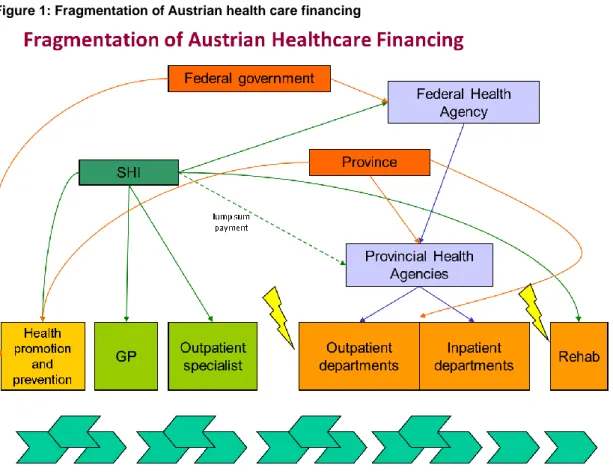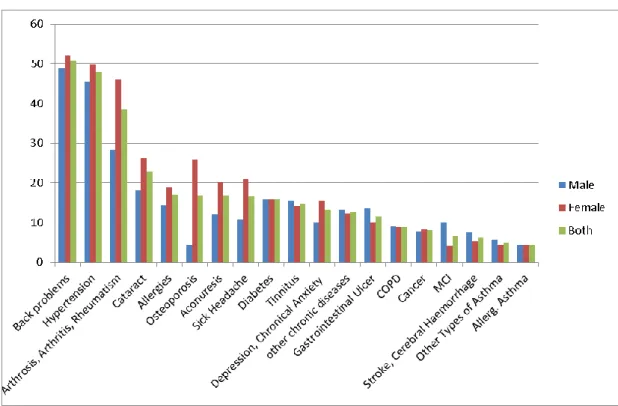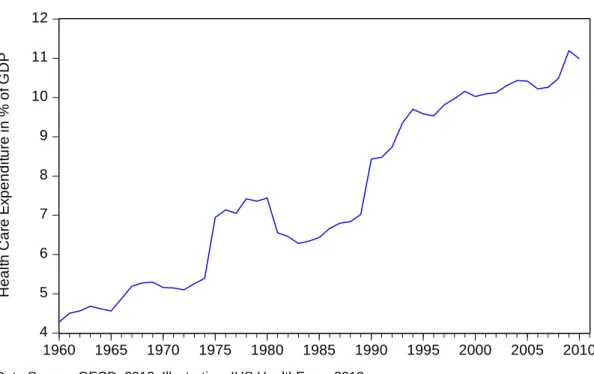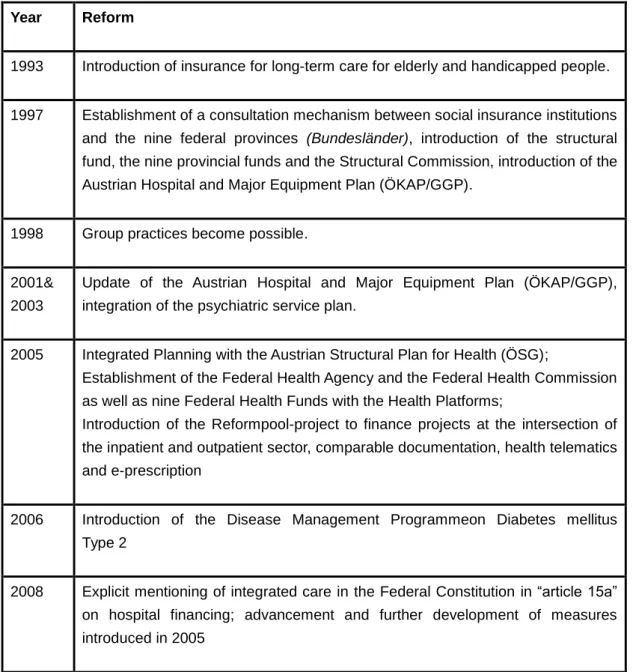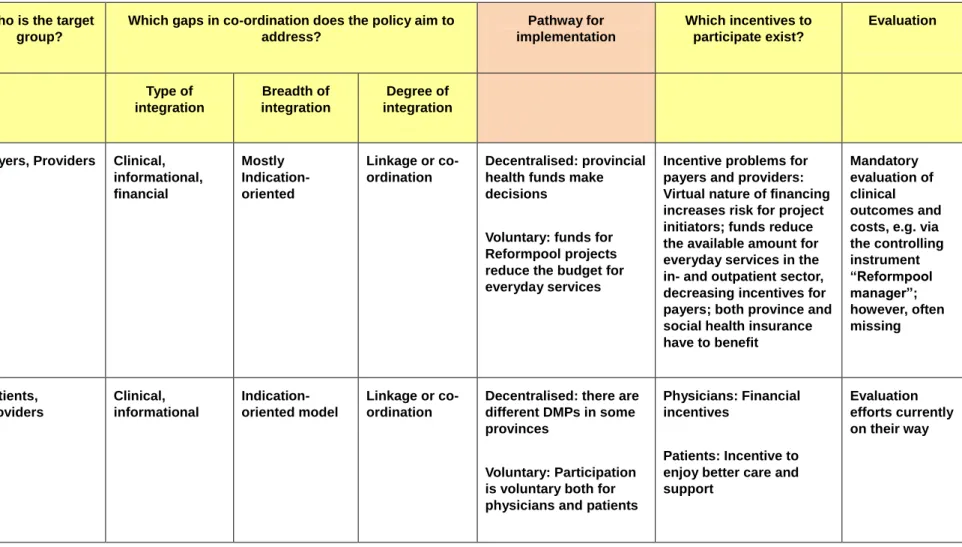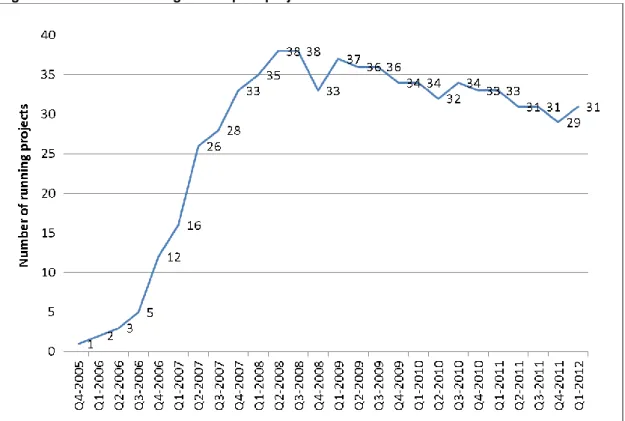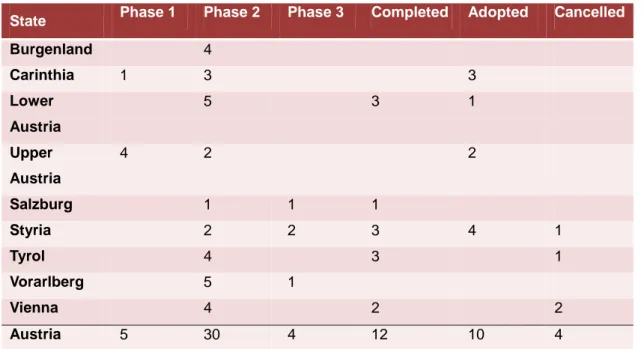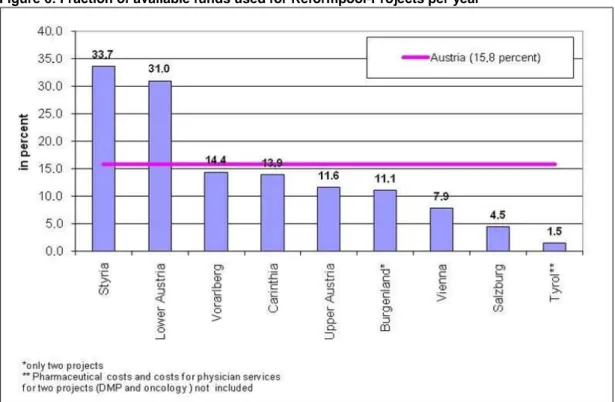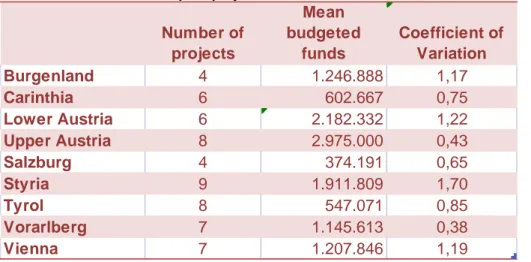Towards better care co- ordination for people with
chronic conditions:
An analysis of reform processes in Austria
Thomas Czypionka Susanna Ulinski Brigitte Hochmuth
2 - Czypionka, Ulinski, Hochmuth / Towards better care co-ordination — I H S
Towards better care co- ordination for people with
chronic conditions:
Ananalysis of reform processes in Austria
Thomas Czypionka Susanna Ulinski Brigitte Hochmuth
with contributions by Michael Berger Final report
Report on behalf of London School of Economics and Political Science October2012
Research Report
Institut für Höhere Studien (IHS), Wien Institute for Advanced Studies, Vienna
2 - Czypionka, Ulinski, Hochmuth / Towards better care co-ordination — I H S
Contact:
Dr. Thomas Czypionka
: +43/1/599 91-127 email: czypionk@ihs.ac.at
Table of contents
1. Introduction 1
2. Attempts to improve care co-ordination 3
2.1. Rising demand for Co-ordinated Care ... 5
2.2. Key National Policies and Reforms in the Health Care Sector ... 6
2.3. Reformpool ... 9
2.4. Disease Management Programmes ... 10
3. Assessment of the status quo 12 3.1. Reformpool ... 12
3.2. Disease Management Programmes ... 17
4. Analysis of Barriers and Facilitators 21 4.1. Key influencing factors ... 21
4.2. Reformpool ... 29
4.3. Disease Management Programmes ... 33
5. Conclusions based on the case study 44
References 46
2 - Czypionka, Ulinski, Hochmuth / Towards better care co-ordination — I H S
List of figures
Figure 1: Fragmentation of Austrian health care financing ... 2
Figure 2: Stylised facts ... 3
Figure 3: Chronic diseases at the age of 60+ in Austria... 4
Figure 4: Austrian health care expenditure in % of GDP between 1960 and 2010 ... 5
Figure 5: Number of running Reformpool-projects ... 13
Figure 7: Fraction of available funds used for Reformpool-Projects per year ... 15
Figure 8: Map of implementation of DMP Therapie Aktiv in Austria ... 18
List of tables
Table 1: Timeline of key reforms impacting on care co-ordination ... 8
Table 2: Characteristics of selected policies to improve care co-ordination in Austria ... 11
Table 3: Reformpool-activities by provinces ... 14
Table 3: Statistics of Reformpool-projects ... 16
Table 4: Therapie Aktiv-participants ... 19
Table 5: Progress and stagnation in the implementation of care co-ordination policies ... 20
1. Introduction
The Austrian health care system shows a federalist and decentralised structure with a public- private mix in provision. In particular, the federal government, the nine federal provinces and self-governed social health insurance (SHI) are the key players in the health care sector.
According to article 10 of the Austrian constitution, the federal government has responsibility over most areas of the Austrian health care system. The most important exception is the hospital sector, where according to article 12 of the Austrian constitution the basic framework is defined by federal law while more detailed legislation as well as its execution is the responsibility of the nine federal provinces excluding sanitary supervision, which is carried out by the district administration as agent of the federal government.
Problems of health care are rooted in the structures of sectoral segmentation. Additionally, these problems are intensified by the financing mechanisms which are partly determined by the Austrian federalist structure.
Health care in Austria has developed into a supply model based on decentralised contracts with service providers. These contracts are negotiated between health insurance funds and private service providers for the outpatient sector, whereas in the inpatient sector, federal and state cooperation is necessary, together with some non-profit hospital owners. This cooperation is governed by agreements based on “article 15a” of the Austrian constitution, which is renewed every three or five years. The outpatient and rehabilitation sectors are mainly the competence of the different social insurance institutions (all three areas: work- accident insurance, health insurance and pension insurance in the case of rehabilitation), whereas the inpatient sector is financed by the State Health Funds. This composition leads to an imbalance of cost objects because the Social Security Institutions contribute a lump- sum payment to the State Health Funds (about 43% of patient-relevant hospital costs) but do not have a voice in decision-making processes. Interface problems, therefore, lie especially in the fragmentation of the inpatient and outpatient sector, but also occur between preventive measures, general practitioners, medical specialists and rehabilitation, as there are no joint data infrastructures or electronic patient records yet. Interface problems between the inpatient and outpatient sector can be traced back to the mercantilist-cameralist movement in the 18th and 19th century that played a strong role in the provision of public infrastructure.
It had a major influence on the development of hospital services leading to a strong link of organisation and financing of the Austrian health care sector and state institutions (Theurl, 1999). This affinity was strengthened by the general act on social insurance (“Allgemeines Sozialversicherungsgesetz”) coming into force.
The following Figure 1 gives an overview of the Austrian situation of sectoral fragmentation in health care financing. Interface problems are illustrated with flashes and moreover the lack of coordination among sectors is represented by the separation of the boxes.
2 - Czypionka, Ulinski, Hochmuth / Towards better care co-ordination — I H S
Figure 1: Fragmentation of Austrian health care financing
Source: Czypionka and Röhrling, 2009
In addition, the segmented organisation of the inpatient sector among the nine federal provinces can lead to an inefficient provision of specialisations and services between hospitals (i.e. a hospital in Upper Austria offers the same specialised services as a neighbouring hospital ten kilometres away in Salzburg). The Austrian Structural Plan for Health, developed on the federal level and broken down into regional structure plans, has not yet succeeded in providing more co-ordination across borders.
Hitherto, no overall electronic system of health records that has the advantage of providing full information of a patient’s medical history and prescriptions has been implemented. The aim of an electronic health record is to avoid parallel services and the prescription of inappropriate drugs as well as to provide co-ordinated care over time. Major drawbacks concern data privacy and the abuse and illegal access to collected data. On top of that, there is apparently opposition to more transparency. The first step in this direction has been taken with the Austrian Health Care Reform in 2005 in which supplements of data privacy requirements were specified.
The challenges that have to be overcome in order to provide co-ordinated care for people with chronic conditions lie primarily in the structural and financial segmentation of the Austrian health care system. Furthermore, the country’s federalist structure hinders efficient nationwide planning.
Subsequently, a case study analysing policies to improve care co-ordination is presented.
The second chapter gives a historical overview of attempts that were taken in order to improve care co-ordination. In the third chapter, the status quo of Austrian health policies is assessed. Barriers and facilitators of implementing better care co-ordination in Austria are identified and analysed in chapter four, before the conclusion follows in chapter five.
2. Attempts to improve care co-ordination
The demographic development will weigh heavy on the Austrian healthcare system especially in the second and third decade of the century. Additionally, the epidemiological change towards chronic illness affects Austria as much as many other highly developed countries.
Figure 2 gives an overview of the comparison of past and current life expectancies, disease spectrum, possible treatments and the share of elderly people. The projected life expectancy at birth in 2030 is about 13 years higher than in 1971, with an increase of almost 60% of people at the age of 65 and above. These developments and further medical progress led to a change in the disease spectrum from acute to chronic and turning possible treatments form
“eminence-based” to “evidence-based”.
Figure 2: Stylised facts
Source: Statistik Austria (key indicators, forecasts), display: IHS HealthEcon, 2012
The shift from acute to chronic diseases has major implications for the provision of medical services. Chronic diseases require trans-sectoral, evidence based care, which has to overcome interface problems between the inpatient and outpatient sector. The Austrian Health Interview Survey (HIS) determines which chronic diseases are the most common.
Figure 3 shows the results of the HIS of 2006/2007 for people at the age of 60 and older. In addition, as people grow older and increasingly suffer from chronic diseases, multi-morbidity is more likely.
4 - Czypionka, Ulinski, Hochmuth / Towards better care co-ordination — I H S
Figure 3: Chronic diseases at the age of 60+ in Austria
Source: Statistik Austria Health Interview Survey 2006/2007, Illustration: IHS HealthEcon, 2012
Austria’s expenses on health care are among the highest in the European Union and the proportion of GDP spent on health care increases. Figure 4illustrates the development of health care expenditures in Austria as a share of GDP from 1960 to 2010. Since 1990 total expenditures on health care rose from about 7% to 11% in 2009. The increase is mainly due to the aging population, increased coverage and improvements in medical technology. In 2008 expenditures in per cent of GDP rose sharply because of a decline of GDP due to the financial crisis, even though they remained on a similar level. For this reason, the
“affordability” of health care under the principles of maintaining or even augmenting the current quality level has been the main objective of the reforms undertaken.
Figure 4: Austrian health care expenditure in % of GDP between 1960 and 2010
Data Source: OECD, 2012; Illustration: IHS HealthEcon, 2012
2.1. Rising demand for Co-ordinated Care
Co-ordination was first demanded in the field of psychiatric care and care for elderly people.
In 1987, for example, Badelt (1987) pointed out the necessity for co-ordinated care for elderly people in Vorarlberg.
The first legal step towards co-ordinated care can be found in the development plans for the
“article 15a” agreement of 1993. The agreement states that services in all settings of care have to be provided in a co-ordinated way. Even though provinces are responsible for the provision of long-term care, all provinces are required to follow the same principles and broad goals of care (Kraus & Riedel, 2010).
Although the fragmentation of the inpatient and outpatient sector has been in place since the 19th century, there were only few demandsfor reform until the late 1990s. Theurl (1999, p.333) mentions this problem explicitly:
“The huge differences in the historical development of different provinces relates to the differing ownership structure of public hospitals. The split of the service guarantee is one important reason for the lack of integrated forms of health care services”.
One principal reason to address these intersection problems in the late 1990s was that the Federal Government and the social security institutions tried to contain cost.
4 5 6 7 8 9 10 11 12
1960 1965 1970 1975 1980 1985 1990 1995 2000 2005 2010
Health Care Expenditure in % of GDP
6 - Czypionka, Ulinski, Hochmuth / Towards better care co-ordination — I H S
In 2000, the Austrian Court of Audit addressed this point in its perception report about the Austrian health care reform and hospital financing. The Austrian Court of Audit criticised that the structural commission failed to force structural changes in the health care sector and to further care integration. It also indicated that it is difficult to overcome the complexity of co- ordination caused by the jurisdictional tangle of inpatient, outpatient, care and rehabilitation sectors. From 2000 onwards, the Austrian Court of Audit repeatedly pointed out the lacking efforts to overcome the sectoral fragmentation in the health care system, i.e. the report examining the health care reform of 2005 gives a sobering impression of the impacts of measures taken (Österreichischer Rechnungshof, 2010/2).
2.2. Key National Policies and Reforms in the Health Care Sector
In 1978, the first “15a agreement” with a “revenue-oriented expenditure policy” was enacted in order to contain costs. Later, in the 1990’s, the Austrian National Assembly agreed on a number of reforms with the key aim to ensure the financial sustainability of the health care system.
The reforms of 1997 included the introduction of the Austrian DRG system
“leistungsorientierte Krankenanstaltenfinanzierung” (LKF), covering only the inpatient departments. In terms of attempts to improve care co-ordination, a consultation mechanism between the social insurance institutions and the federal provinces was established. In case that the federal provinces infringe jointly agreed plans, a sanctioning mechanism was defined but never used so far. Additionally, the Austrian Hospital and Major Equipment Plan (ÖKAP/GGP) was established, which also included schemes for hospital outpatient departments, a location plan for fund-contracted physicians, a long-term care sector plan and a rehabilitation plan.
The ÖKAP/GGP not only specified the locations of hospitals but also stipulated services offered and the number of beds per hospital. Due to the changing age structure and the variation of encountered diseases in acute medical care, the plan was revised and extended in 1999. For the first time, sectors of acute geriatrics/remobilisation and concepts for coverage with palliative care were included in the plan as well as the integration of a psychiatry plan and the inclusion of minimum standards for intensive care units. The success, however, was minimal, as the provinces objected to this strong federal influence in their agenda. Nevertheless, most likely due to the delicate relations between the federal and provincial governments, the sanction mechanism was never used.
Between 2000 and 2004, another set of reforms was introduced with the main objective of cost containment and budget consolidation. These reforms resulted in a harmonisation of contribution rates of different groups (i.e. wage and salary earners) and an increase in the rates to additionally cover the risks of leisure time accidents. Furthermore, contributions of pensioners rise annually by 0.25 percentage points until they reach 4.75 % of the respective
pension. Another important aspect of these reforms is the agreement between the federal government and the federal provinces on quality work with defined quality goals. Projects were implemented focusing on topics such as patient orientation, interface management and quality reporting.
In addition, the ÖKAP/GGP was updated according to demographic and medical developments in 2001 and 2003. Part of the reform was the integration of the first psychiatric services plan (Hofmarcher & Rack, 2006).
In 2005, the implementation of various measures with the main objectives of budget consolidation, cost containment and quality assurance followed based on the Health Care Reform of the same year. The Health Care Reform’s emphasis is laid on integrated care and interface management. The 73rd agreement pursuant to “article 15a”, edited on July 12, 2005, formulates the intention to erase the existing fragmentation of current sectors of service provisions in article 3 (integrated Structural Plan for Health) and explicitly names inpatient and ambulatory care, rehabilitation and other care sectors. In addition, an area- wide and intra-sectoral hospice and palliative care system should be planned and introduced. Furthermore, the compulsory basis for integrated planning is implicitly defined in the Austrian Structural Plan for Health, in Article 5, clause 3 (Republik Österreich, 2005).
The Health Care Reform 2005 aimed to (Herber, 2007):
overcome the sectoral boundaries in the health care system and to improve the co- ordination of planning, controlling and financing;
assure long-term financial management with measures of cost containment and raising efficiency;
support preventive measures and nationwide indemnification and improvement of quality;
enforce transparency;
promote interface management and
match the requirements for the use of information technology.
As part of the framework of the Health Care Reform 2005 an “area of cooperation” within the State Health Funds was defined, encompassing the tasks lying in between the inpatient and outpatient sector. Projects at this interface can be financed by the so-called Reformpool.
Furthermore, harmonisation of documentation, of clear demarcation of contents and the assignment of scores to case-based payments in other areas of care should lead to better adjustment of the Austrian DRG model to the possibilities of service-provision in the outpatient-sector and registered doctors-sector. Another instrument to develop integrated health care in Austria was the Austrian Structural Plan for Health, which is the basis for integrated planning of the Austrian health care structure pursuant the 2005-2008 15a agreement and represents the framework for the overall planning on the regional level
8 - Czypionka, Ulinski, Hochmuth / Towards better care co-ordination — I H S
(Bundesministerium für Gesundheit, 2012a). This plan involves inpatient and outpatient care as well as acute and long-term care, including rehabilitation and interfaces between care sectors, as a successor to the ÖKAP/GGP. Table 1 gives an overview of the key reforms addressing the coordination of care.
Table 1: Timeline of key reforms impacting on care co-ordination Year Reform
1993 Introduction of insurance for long-term care for elderly and handicapped people.
1997 Establishment of a consultation mechanism between social insurance institutions and the nine federal provinces (Bundesländer), introduction of the structural fund, the nine provincial funds and the Structural Commission, introduction of the Austrian Hospital and Major Equipment Plan (ÖKAP/GGP).
1998 Group practices become possible.
2001&
2003
Update of the Austrian Hospital and Major Equipment Plan (ÖKAP/GGP), integration of the psychiatric service plan.
2005 Integrated Planning with the Austrian Structural Plan for Health (ÖSG);
Establishment of the Federal Health Agency and the Federal Health Commission as well as nine Federal Health Funds with the Health Platforms;
Introduction of the Reformpool-project to finance projects at the intersection of the inpatient and outpatient sector, comparable documentation, health telematics and e-prescription
2006 Introduction of the Disease Management Programmeon Diabetes mellitus Type 2
2008 Explicit mentioning of integrated care in the Federal Constitution in “article 15a”
on hospital financing; advancement and further development of measures introduced in 2005
Sources: Bundesministerium für Gesundheit, 2012b; Czypionka & Röhrling, 2009; Hofmarcher & Rack, 2006
2.3. Reformpool
In the framework of the Austrian health care reform in 2005, the cooperation area within the state health funds was defined. This area covers those tasks in between the in- and outpatient sector. As neither the provincial health funds nor social security institutions are fully responsible for these tasks, financial issues arise. The Reformpool is a fund for projects concerning specifically these interfaces. The principal aim of those projects is a service shift between the in-and outpatient sector benefiting both the provinces and social security institutions. For the years 2005 and 2006 up to 1% of total health care expenditure could be reserved for such Reformpool-projects. In 2007 and 2008 the amount could be raised up to 2% (Czypionka & Röhrling, 2009). These funds represent only a virtual cap and if projects were not commissioned, they remained and could be used for regular health care activities.
In 2005, the Federal Health Agency published guidelines for the Reformpool projects specifying goals, suitability, documentation, evaluation and the institutionalisation of a regular exchange of information. The expansion and actualisation of the “article 15a” agreement in 2008 explicitly states the aim of financing projects on integrated care (Czypionka & Röhrling, 2009) and that documentation of the status quo and of the change in performance outcomes is required. Regarding the issue of the merely virtual availability of Reformpool-funds, there was only a re-formulation in the actualisation of the “article 15a”- agreement in 2008, but the funds remain virtual.
In addition, further guidelines were passed containing province-specific special regulation for the course of projects. For example, in Upper Austria, these guidelines point out that anybody has the right to submit a project whereas the costs of formulating the project idea have to be paid for by the applicant. The Health Platforms can afterwards admit the project to the next phase in which it is submitted as a Reformpool-project. The costs of the second phase still have to be borne by the applicant. The second phase ends with the handover of a report to the state health fund. If the health platform decides in favour of the project, a realisation project starts.The project ends with a report containing the evaluation of forecast effects. In connection with the report, the applicant submits a Reformpool-plan suggesting a real operation of the project. If the health platform approves of it, the real operation starts with on-going evaluation during the process. It is necessary that the Reformpool-project is beneficial for both the provinces and SHI. This Reformpool process cycle seems complicated but comes with the advantage of permanent monitoring (Czypionka & Röhrling, 2009).
The ultimate goal after the test of the project and positive evaluation is the introduction of the project into real operation, financed by the provincial health funds or SHI.
10— Czypionka, Ulinski, Hochmuth / Towards better care co-ordination — I H S
2.4. Disease Management Programmes (DMPs)
Disease Management Programmes (DMPs) structure the process of care and thus try to overcome several shortcomings of current medical practices. They are primarily used to treat patients with chronic diseases. DMPs started in the USA with the launch of blood glucose monitoring for Diabetes patients in the 1980s followed by various DMPs in the 1990s (Chandaver, 2007). The Disease Management Association of America defines Disease Management as a “system of co-ordinated health care interventions and communications for populations with conditions in which patient self-care efforts are significant” (Care Continuum Alliance, 2011). Patients should be motivated via these programmes to better manage their disease. In addition, the aim is to monitor them actively following evidence-based guidelines and to co-ordinate care among all providers (Congressional Budget Office, 2004).
The motivation to introduce DMPs in Austria started with rising health care expenditures.
Since the health care reform of 2005, there are several DMPs in Austria dealing among others with Diabetes mellitus type 2, strokes, breast cancer, palliative care and coronary heart diseases. In 2004 the Styrian sickness fund and the Institute for Biomedicine and Health Science of Johanneum Research started to develop a DMP on behalf of Austrian SHI’s programme “Therapie Aktiv” (Österreichische Sozialversicherung, 2006). The programme was implemented in 2007 (Therapie Aktiv, 2012a). It consists of regular examinations, training, the agreement to individual targets with a practitioner and informative literature. Patients can participate free of charge and voluntarily in the DMP and terminate their participation at any time. During the regular examinations, the physician conducts (or refers the patient to) a haemodynamometry and a weight check, every six months an HbA1c- control and once a year an anamnesis, a foot inspection, a check on neuropathy, ophthalmologic control, cardiovascular risk stratification and an urine test (Czypionka et al.
2011). The national quality guidelines for DMPs (Bundesqualitätsleitlinien) should ensure a nationwide and trans-sectoral quality level, anchored in the national law for quality of health care services (GQG).
Physicians are paid for their service provided and, in addition, receive a capitation payment per treated DMP-patient per quarter. The physician completes a documentation form when the patient is registered with the DMP and subsequently every year. The physician is obliged to participate in a four-hour basic training and thereafter in a two-hour refreshing course every two years. The remuneration for physicians participating in “Therapie Aktiv” differs across regions depending on the specific health insurance fund. In Lower Austria, the physician is remunerated with 53 € for the first examination and afterwards is paid 25 € per quarter in addition to usual fees. For the training of insulin-dependent patients in small groups (three to five), a doctor receives 1,064 € (Czypionka et al. 2011). The remuneration in Upper Austria is comparable, as physicians receive 66 € for the first examination, 19 € and 43 € for the quarterly and annual check-up respectively as well as 690.39 € for the training of a diabetes-group (OÖGKK 2011).
Table 2: Characteristics of selected policies to improve care co-ordination in Austria Who is the target
group?
Which gaps in co-ordination does the policy aim to address?
Pathway for implementation
Which incentives to participate exist?
Evaluation
Type of integration
Breadth of integration
Degree of integration
Reformpool Payers, Providers Clinical, informational, financial
Mostly Indication- oriented
Linkage or co- ordination
Decentralised: provincial health funds make decisions
Voluntary: funds for Reformpool projects reduce the budget for everyday services
Incentive problems for payers and providers:
Virtual nature of financing increases risk for project initiators; funds reduce the available amount for everyday services in the in- and outpatient sector, decreasing incentives for payers; both province and social health insurance have to benefit
Mandatory evaluation of clinical outcomes and costs, e.g. via the controlling instrument
“Reformpool manager”;
however, often missing
Disease Management Programmes
Patients, Providers
Clinical, informational
Indication- oriented model
Linkage or co- ordination
Decentralised: there are different DMPs in some provinces
Voluntary: Participation is voluntary both for physicians and patients
Physicians: Financial incentives
Patients: Incentive to enjoy better care and support
Evaluation efforts currently on their way
12— Czypionka, Ulinski, Hochmuth / Towards better care co-ordination — I H S
3. Assessment of the status quo
As previously mentioned the main aim of the health care reform was to overcome sectoral boundaries in the health care system and to achieve improvements in the co-ordination of planning, controlling and financing in order to finance the Austrian health care system in a more sustainable way. The previous “article 15a” agreements included plans for integrated care. The new “article 15a” agreement 2008-2013 and the new Reformpool-guidelines explicitly address integrated care for the first time, although projects already contained elements of integrated care before. Another key factor of the reform was information management. The introduction of an electronic medical record (ELGA) has the aim to provide seamless communication between hospitals, general practitioners and specialists and in this way contribute to overcome the fragmentation of the inpatient and outpatient sector. Up to now, ELGA has not yet been launched as several stakeholders are opposed.
Regarding co-ordinated care, the Reformpool-projects and disease management lie at the core of the reform and their status-quo will be analysed in the following chapters.
3.1. Reformpool
(1) Development of structures
The aim of the Reformpool is to solve existing interface problems by installing a common pool of funds for projects within the provincial health funds. Reformpool projects were expected to extend the breadth of integration across interfaces. The new Reformpool- guidelines of 2008 make it explicitly possible to sponsor projects of integrated care, which had de facto already been the case before (Czypionka & Röhrling, 2009). In theory, anyone can develop a Reformpool project but, so far, mainly social security institutions and federal provinces have designed projects. It is difficult, though, to determine in what function federal provinces act as they are a political entity and additionally responsible for financing the inpatient sector. Up to 1% (in 2005 and 2006) and 2% (in 2007 and 2008) of total in- and outpatient expenditure could be made available for Reformpool-projects. The available funds, though, were not reserved for those projects, but reduced the total amount that could be spent in the inpatient and outpatient sectors. Notwithstanding, tariffs in the outpatient sector and hospital costs remained the same.
(2) Participation of SHI funds and providers
An analysis of Reformpool-activities by Czypionka and Röhrling (2009) shows a hesitant start in the first two years with an upswing in 2007, which was followed by a downturn in the following years. Error! Reference source not found. reflects a similar pattern, illustrating the number of running projects reaching from the fourth quarter of 2005 to the fourth quarter of 2010. In the third quarter of 2008, Reformpool-activity reached its peak at 38 simultaneously running projects. During the last quarter of 2011 the number of current
projects decreased to 29. The average duration of a project is about 43 months (Czypionka
& Röhrling, 2009).
Figure 5: Number of running Reformpool-projects
Source: IHS HealthEcon questionnaire 2009, “Health System Watch”-Update 2012
The progress of Reformpool-projects can be divided into three phases. Initially, the concept and design of the project is presented in phase one. In phase two, the project is authorised and implemented, before the evaluation follows in phase three. After the final evaluation, the Reformpool-project is either adopted into routine care or brought to an end (Bundesministerium für Gesundheit, 2012c). Table 3 gives an overview over the state of affairs of Reformpool-projects across provinces. In the third quarter of 2012, 30 Reformpool- projects are running. Moreover, five projects are scheduled and four projects are under final evaluation. Out of the 22 projects that have been completed successfully, ten have been adopted into routine care. Besides, four projects were discontinued during the process.
14— Czypionka, Ulinski, Hochmuth / Towards better care co-ordination — I H S
Table 3: Reformpool-activities by provinces
State Phase 1 Phase 2 Phase 3 Completed Adopted Cancelled
Burgenland 4
Carinthia 1 3 3
Lower Austria
5 3 1
Upper Austria
4 2 2
Salzburg 1 1 1
Styria 2 2 3 4 1
Tyrol 4 3 1
Vorarlberg 5 1
Vienna 4 2 2
Austria 5 30 4 12 10 4
Source: Bundesministerium für Gesundheit 2012c (latest update June 11, 2012), Display:
IHS HealthEcon 2012
The majority of the projects (79%) deals with integrated care like the DMPs for Diabetes Mellitus type 2 and stroke units (Upper Austria, Styria, Tyrol and Vienna), care of coronary heart diseases (Lower Austria, Styria), care of nephrological diseases (Styria) and Discharge-/Interface-/Case- and Care Management (Burgenland, Lower Austria, Salzburg, Styria, Vorarlberg and Vienna) (Czypionka & Röhrling, 2009).
The virtual nature of the Reformpool-funds caused the actual sum of investment to be much lower than 1% (2% respectively) of total in- and outpatient expenditure. On an aggregate level, only 15.8% of possible funds were used for Reformpool-investments per year in Austria. However, the activities among the nine provinces are quite different and reach from 33% in Styria to only 1.5% in Tyrol. Figure 6 illustrates the fraction of money actually used for Reformpool-projects as share of the money available.
Figure 6: Fraction of available funds used for Reformpool-Projects per year
Source: IHS questionnaire 2009
(3) Participation of patients
The number of participating patients varies among projects. Czypionka and Röhrling (2009) analysed first Reformpool-evaluations and found that for example in Vorarlberg, it was assumed that 45 to 60 patients would take part in the project “mobile healthcare”, in total 53 patients participated from October 2007 to August 2008. Another project regarding palliative care intended to reach 100 patients, but the actual number was only about one third. In the training project for Diabetes mellitus type 2 in Carinthia, more than 2,000 patients participated in the initial training, but the participation rate for follow-up trainings declined to 40%. Furthermore, care-level varies highly among Carinthian districts, in the region of St.Veit/Glan only about 20 per cent of potential patients were trained.
(4) Availability of evaluations
Several Reformpool-projects can be considered as a success, both in medical and in economic terms. Several laws were enacted to ensure quality control (Health Quality Act), including several guidelines. Czypionka et al. (2006) analysed the evaluation procedure of quality control in medical practices that has been made compulsory for every office-based physician. However, they found that the methodology of the evaluation procedure itself has to be called into question.
The following Table 4 illustrates the number of Reformpool-project per federal province, their mean of budgeted funds as well as the coefficient of variation for 2011. The highest average
16— Czypionka, Ulinski, Hochmuth / Towards better care co-ordination — I H S
amount of funds was planned in Upper Austria, followed by Lower Austria and Styria. The lowest average budget for Reformpool-projects was planned in Tyrol and Salzburg. The lowest-budgeted project is only about € 60,000, whereas, on the contrary, the project with the highest financial volume, the “hospice and palliative care institution” of Styria, has a total budget of € 9,500,000. It has to be mentioned though, that the size and therefore the costs of the projects are quite divergent, reducing the informative value of the average budgeted funds.
Table 4: Statistics of Reformpool-projects
Source: Czypionka and RöhrlingUpdate 2012
Although there is financial potential for such projects, there is no guarantee that a project will be adopted as a regular service or spread to other regions even if it is successful.
The project “interdisciplinary admission department Horn” in Lower Austria is an example of a successful realisation of the Reformpool. Through this project, a significant reduction in hospital admission and days spent in the hospital as well as a cost reduction of € 2.4 million could be achieved. Additionally, a survey showed that both participating patients and physicians are satisfied with the project. The evaluation of another Lower-Austrian project (“integrated hospice- and palliative care in Lower Austria”) showed that cumulated synergies exceeded costs and satisfied persons concerned. The project “mobile palliative-team” in Vorarlberg is seen as a success too because life- and care-quality of palliative patients could be improved and inpatient palliative stations could be disburdened. Due to the lack of evaluation in many cases, not all benefits from the projects could be assessed.
Comprehensive evaluations of the health and economic implications of Reformpool-projects remain scarce. The reluctance to evaluate is strengthened by the fact that it is still unclear whether the evaluation of Reformpool-projects is mandatory. The phrasing in the national guidelines is such that projects have to be evaluated, and that the guidelines are passed by the Federal Health Commission. But the legal status of such decisions by the FHC is not well-defined, which leads to confusion whether resolutions are legally mandatory.
Number of projects
Mean budgeted
funds
Coefficient of Variation
Burgenland 4 1.246.888 1,17
Carinthia 6 602.667 0,75
Lower Austria 6 2.182.332 1,22
Upper Austria 8 2.975.000 0,43
Salzburg 4 374.191 0,65
Styria 9 1.911.809 1,70
Tyrol 8 547.071 0,85
Vorarlberg 7 1.145.613 0,38
Vienna 7 1.207.846 1,19
Independent from this question, there are no sanctioning mechanisms in place for not evaluating a project.
For projects that are actually evaluated, results indicate the potential of cost reduction.The project “Interdisciplinary receiving station Horn” in Lower Austria, for example, could reduce costs by about € 2.4 million, which was even above the expected amount of € 2 million. The Upper-Austrian project “Diabetes Care Upper Austria” resulted in a total amount of € 49 per patient which compares favourably to a random sample of the basic population of diabetes patients.
3.2. Disease Management Programmes
(1) Participation of SHI funds
The DMP “Therapie Aktiv” is used as representative of DMPs in Austria. As DMP for Diabetes Mellitus type 2, “Therapie Aktiv”, is the most widespread programme in Austria and is either a Reformpool-project or already adopted to daily routine in the provinces of Lower Austria, Salzburg, Styria, Vorarlberg, Vienna and Upper Austria (Czypionka et al., 2011). In Burgenland, a proprietary Disease Management Program called “Modell Burgenland” was introduced. Tyrol tested “Therapie Aktiv” as a Reformpool-project but did not adopt it to daily routine and it ended on December 31, 2010. For Carinthia, plans exist to implement
“Therapie Aktiv”. Figure 7 shows a map of Austria, denoting the regions where “Therapie Aktiv” is in use. The orange colour shows federal provinces that implemented the programme; yellow denotes provinces with other DMPs and provinces pictured in grey do not currently have DMPs for Diabetes mellitus type 2 but offer trainings for patients suffering from diabetes.
18— Czypionka, Ulinski, Hochmuth / Towards better care co-ordination — I H S
Figure 7: Map of implementation of DMP Therapie Aktiv in Austria
Source: Therapie Aktiv, 2012; Translation: IHS 2012
(2) Participation of physicians and patients
Table 5 shows participating physicians and patients of the DMP “Therapie Aktiv”. Compared to the total number of eligible outpatient physicians, the number of physicians participating in a DMP is quite low compared to other countries (i.e. Germany). General practitioners and specialists for internal medicine (both contracted and without a contract) are eligible to participate.In total, about 15.3% of eligible physicians participate in the DMP-programme
“Therapie Aktiv”. Vorarlberg and Upper Austria show a participation rate of physicians above average, whereas in Lower Austria and Vienna the number of registered physicians is still quite low. In addition, estimates assume about 420,000 diabetics (Wawrosky, 2010) in Austria, of which only about 7.7% currently participate in the DMP “Therapie Aktiv”. In Germany, the participation rates of Diabetes mellitus type 2 DMPs are estimated to be around 50% (Czypionka et al., 2011). The goal is to raise participation up to two-thirds of all pharmaceutically treated diabetes patients.
Table 5: Therapie Aktiv-participants
Federal State
Currently participating
physicians
Eligible physicians1
Share of participating
physicians
Currently participating
patients
Lower Austria 152 1556 9.77% 5,081
Upper Austria 300 1196 25.08% 8,152
Salzburg 101 514 19.65% 1,777
Styria 222 1145 19.39% 6,952
Vorarlberg 69 290 23.79% 1,058
Vienna 167 1904 8.77% 8,829
Sum 1011 6605 15.31% 32,569
Source: Therapie Aktiv (2012) (status September 2012), Ärztekammer (2012) and Ärzteverlagshaus(2012), display IHS HealthEcon 2012
Note: Only federal provinces with current Therapie Aktiv-projects are listed
A survey of participating practitioners and diabetics of “Therapie Aktiv” in Styria showed improved health outcomes for patients. Furthermore, 98% of total participants declared that they found it important to be involved in the DMP. Both diabetics and physicians look favourably upon the “Therapie Aktiv”-programme (Steiermärkische Gebietskrankenkasse 2009 in: Czypionka et al. 2011), as the process-quality of diabetes-treatment could be improved significantly.
Table 6 offers a concluding overview of the progress and stagnation of DMPs and integrated care contracts in Austria.
1Only general practitioners and internists (contracted or without contract) can participate in the “Therapie Aktiv”- programme
20— Czypionka, Ulinski, Hochmuth / Towards better care co-ordination — I H S
Table 6: Progress and stagnation in the implementation of care co-ordination policies Parameter of (intermediate)
policy effect (‘success’ or
‘failure’)
Disease management programmes Reformpool
Up-take by payers Up-take is differing by provinces; some successful projects such as “Integrierte Versorgung Schlaganfall” in Upper Austria are not spread to other provinces
High up-take in 2007 and 2008
BUT: Since 2009, evidence suggests largely stagnation in the number of running projects and because of the virtual character of funds, the incentive to start projects is very low
Up-take by providers Physicians’ acceptance and participation is still a weakness, they oppose the extensive
administration/documentation required
High up-take in 2007 and 2008
BUT: stagnation since 2009 Up-take by patients Patient enrolment is low compared to other countries e.g.
Germany
Low number of participants
Development of structures Documentation has been reduced
Intention to integrate required documentation in physician’s software
In some provinces (e.g. Styria) provision of help to re- structure the organisation of medical practices
Virtual availability of fund is the main problem, the new
“article 15”-agreement did not improve this issue
Still no legal obligation to introduce successful projects to regular operation
Availability of evaluations Thorough evaluation hardly exists or is not published
Concerns exist over insufficient quality assurance of medical documentation of DMP participants
Implications for refinement or abolition of the underlying initiatives thus remain unclear
Evaluation exists, but is very difficult to access, the obtained results are ambiguous
Most programmes are not introduced to regular operation or to other provinces
4. Analysis of Barriers and Facilitators
Several stakeholders of the Austrian health care system were interviewed in order to determine likely barriers and facilitators for the implementation of integrated care policies.
The interview partners ranged from representatives of payers, i.e. social security institutions and the federal government, providers like representatives of the Austrian Chamber of physicians, health platforms and ÖGAM (Association of General Medicine) to patients’
representatives and experts in the field of health care. In the following, several findings from literature and the interviews with respect to care-coordination are presented.
Overall, most interviewees share similar opinions on the improvements that can be achieved through better care co-ordination. Patients mainly highlight the advantages of better personal care, easy access to services and information, clearly defined contact persons, the continuum of care and the strong emphasis on the patient’s needs. Providers of health care defined the need to focus on their main tasks which may first result in a reassessment of their structure and finances leading to a clear allocation of tasks, a better flow of information as well as a more efficient and effective use of their own resources. Payers’ identified the reduction of redundancy, more efficient and effective organisational forms as well as the avoidance of over- and under-supply as measures to reduce costs.
One of the interviewed experts summarises possible benefits of better care co-ordination as follows:
The essential advantage would be the separation of care processes for chronically and acutely ill patients and thus reduce the claiming of benefits and with it costs of health care provision. The continuum of care would ensure better outcome, probably reduced costs and less stress for chronically ill patients. In general, the patient’s situation would improve because of less redundancy andless unnecessary appointments. This would cause the patient to feel to be taken care of. I think both patients and the health care system as a whole benefit if unnecessary treatments and costs can be avoided. Providers have to focus and decide what exactly they want to offer. The fragmentation of financing and decision- making is one of the major problems, though.
4.1. Key influencing factors
(1) Challenges in the health care system
Problems of the health care sector are often traced back to the federalist structure alongside the dual financing and sectoral separation. Indeed, the interviews confirm that this point is definitely important and a continuous obstacle for every arrangement that tries to span the
22— Czypionka, Ulinski, Hochmuth / Towards better care co-ordination — I H S
sectoral gap in the Austrian healthcare system. Interviewees point out the problem that various stakeholders with conflicting interests have to agree on guidelines. On several occasions, interviewees mention the existence of wrong frame conditions, e.g. the focus on a maximal instead of an optimal outcome. A representative of the Austrian Ministry of Health defines the most significant challenges for better care co-ordination in the following sentence:
There exist immobile structures, mechanisms and behavioural patterns that have to be newly defined or dissolved, particularly the dual financing and the federalist structure.
This illustrates a point that is relevant to actual change towards a better care coordination:
Habits seem to play an important role in defining the relationship between stakeholders, particularly as ingrained habits are strengthened by the lack of competition. With respect to change, it will definitely be hard to overcome such a long-standing behaviour.
Another stakeholder from the payers’ group thinks that the conflicting interests of stakeholders constitute a major obstacle:
I see the challenges clearly lying with the providers and cost bearers. The cost bearers fail to bring providers together in order to negotiate and set their aims. Providers are very resistant and unfortunately I see deficits in their qualification.
An expert comments on challenges in the health care system as follows:
One major challenge is the disposition of payers to shift benefits; a co-ordinated action between the sectors, confidence in each other’s competencies, to ensure the necessary quality (to act evidence-based); to overcome federalism and the disposition to abide by quality guidelines and report the results.
A patient’s representative sees the problems more in the conflicting interests of the stakeholders involved:
… In reality it’s the payers’ loss of power … the difficulty to take all the stakeholders on board - the ones that are afraid, the ones that are in favour and the ones fearing a loss of power;
and to build up acceptance and transparency.
This problem is reflected in one of Leutz’ (1999) laws of integration: “The one that integrates calls the tunes”.
A representative from the group of payers offers a similar perspective:
The main challenge is to balance the different system-based interests in order to reach a common perspective.
(2) Culture of Evaluation
Several interviewees from the different stakeholders have the opinion that several parts of a culture of evaluation, such as quality monitoring (particularly in the outpatient sector) hardly exist in Austria. Especially, the lack of defined outcome parameters is criticised by stakeholders. Interview partners were asked for their opinion on three different aspects of the culture of evaluation: quality monitoring and assessment, information systems and evidence- based medicine/medical guidelines.
(a) Quality monitoring and assessment
When one of the experts was asked for his opinion on quality monitoring and assessment in Austria, his response was:
In many cases quality monitoring is not existent or only rudimentary. I don’t know about quality monitoring; I only know that assessment on a wide basis and evaluation is carried out.
A sickness fund representative especially sees quality as a problem monitoring and assessment in the outpatient sector:
I think in recent years there was indeed some activity in the field of quality monitoring in the inpatient sector; it’s a subject they are working on, quality monitoring for office-based physicians is still a disaster though.
Another representative from a sickness-fund criticises most notably the lack of outcome parameters:
There is neither process management nor measurement of outcome, mainly because there simply don’t exist any defined outcome parameters.
For the improvement of care-coordination, this definitely poses a problem, as the integration of care naturally encompasses efforts of evaluation.
(b) Information systems
In general, problems regarding information systems occur mainly at the interfaces, since hospitals and groups of physicians or single practices have some form of information system in place already. Another drawback of current information systems is the lack of performance evaluation.
